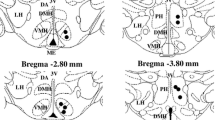Summary
-
1.
Rats were chronically implanted with a hypothalamic cannula to allow chemical stimulation of the hypothalamus on the conscious animals in repeated experiments. Direct administration of cholecystokinin octapeptide (CCK-8) (20–60 ng) into the preoptic anterior hypothalamic area caused a dose-related fall in rectal temperature at ambient temperatures of 8° C and 22° C.
-
2.
The hypothermia induced by CCK-8 was produced by a decrease in metabolism at an ambient temperature of 8° C, whereas at 22° C, it was caused by both a decrease in metabolism and an increase in cutaneous temperature.
-
3.
However, at an ambient temperature of 30° C, intrahypothalamic administration of CCK-8 caused an insignificant change in thermoregulatory responses. Furthermore, neither intrahypothalamic injection of 0.9% saline nor intraperitoneal injection of CCK-8 (60 ng) had any effect on thermoregulatory responses at the ambient temperatures of 8°–30° C studied.
-
4.
Under urethane anaesthesia, 59 single neurons in the preoptic anterior hypothalamic area were examined in 29 rats. Each animal was subjected to scrotal warming or cooling and to the administration of CCK-8. Microiontophoretic application of CCK-8 resulted in inhibition of the majority (75%) of cold-responsive neurons as well as excitation of the majority (77.8%) of warm-responsive neurons recorded in the preoptic anterior hypothalamic area. However, the majority (69%) of thermally unresponsive cells were not affected by CCK-8 application.
-
5.
The data indicate that CCK-8, when administered intrahypothalamically, excites warm-responsive neurons and inhibits cold-responsive neurons within the preoptic anterior hypothalamic area to induce hypothermia by promoting an increase in heat loss and a decrease in heat production.
Similar content being viewed by others
References
Bligh J (1973) Temperature regulation in mammals and other vertebrates. North-Holland, Amsterdam London, p 436
Chi ML, Lin MT (1983) Involvement of adrenergic receptor mechanisms within hypothalamus in the fever induced by amphetamine and thyrotropin-releasing hormone in the rat. J Neural Transmission 58:213–222
Della-Fera MA, Baile CA (1979) Cholecystokinin octapeptide: continuous picomole injections into the cerebral ventricles of sheep suppress feeding. Science 206:471–473
Dockray GJ (1982) The physiology of cholecystokinin in the brain and gut. Br Med Bull 38:253–258
Hardy JD, Gagge AP, Stolwijk JAJ (1970) Physiological and behavioral temperature regulation. Thomas, Springfield, p 944
Hellon RF (1975) Monoamines, pyrogens and cations: Their action on central control of body temperature. Pharmacol Rev 26:289–321
Hellon RF, Misra NK (1973) Neurons in the ventrobasal complex of the rat thalamus responding to scrotal skin temperature changes. J Physiol 232:389–399
Hosford D, Haigler HJ (1980) Morphine and met-enkephalin: Different effects on spontaneous and evoked neuronal firing in the mesencephalic reticular formation of the rat. J Pharmacol Exp Ther 213:355–363
Katsuura G, Itoh S (1981) Effect of cholecystokinin octapeptide on body temperature in the rat. Jpn J Physiol 31:849–858
König JF, Klippel RA (1963) The rat brain: a stereotaxic atlas of the forebrain and lower parts of the brain stem. Williams and Wilkins Company, Baltimore
Lin MT, Chandra A, Tsay BL, Chern YF (1982a) Hypothalamic and striatal dopamine receptor activation inhibits heat production in the rat. Am J Physiol 242:R471-R481
Lin MT, Simon E (1982) Properties of high Q10 units in the conscious duck's hypothalamus responsive to changes of core temperature. J Physiol 322:127–137
Lin MT, Wu JJ, Chandra A, Tsay BL (1982b) A norepinephrinecyclic AMP link in the hypothalamic pathways which mediate fever induced by endotoxin and prostaglandin E-2 in the rat. J Pharmacol Exp Ther 222:251–257
Lin MT, Wu JJ, Tsay BL (1983) Serotonergic mechanisms in the hypothalamus mediate thermoregulatory responses in rats. Naunyn-Schmiedeberg's Arch Pharmacol 322:271–278
Morley JE, Levine AS, Lindblad S (1981) Intraventricular cholecystokinin-octapeptide produces hypothermia in rats. Eur J Pharmacol 74:249–251
Nakayama T, Hammel HT, Hardy JD, Eisenman JS (1963) Thermal stimulation on electrical activity of single units of the preoptic region. Am J Physiol 204:1122–1126
Nakayama T, Hardy JD (1969) Unit responses in the rabbit's brainstem to changes in brain and cutaneous temperature. J Appl Physiol 27:848–857
Nakayama T, Ishikawa Y, Tsurutani T (1979) Projection of scrotal thermal afferents to the preoptic and hypothalamic neurons in rats. Pflügers Arch 380:59–64
Zetler G (1982) Caerulein and cholecystokinin octapeptide (CCK-8): sedative and anticonvulsive effects in mice unaffected by the benzodiazepine antagonist Ro 15-1788. Neurosci Lett 28:287–290
Author information
Authors and Affiliations
Rights and permissions
About this article
Cite this article
Shian, L.R., Lin, M.T. Effects of cholecystokinin octapeptide on thermoregulatory responses and hypothalamic neuronal activity in the rat. Naunyn-Schmiedeberg's Arch. Pharmacol. 328, 363–367 (1985). https://doi.org/10.1007/BF00692901
Received:
Accepted:
Issue Date:
DOI: https://doi.org/10.1007/BF00692901




